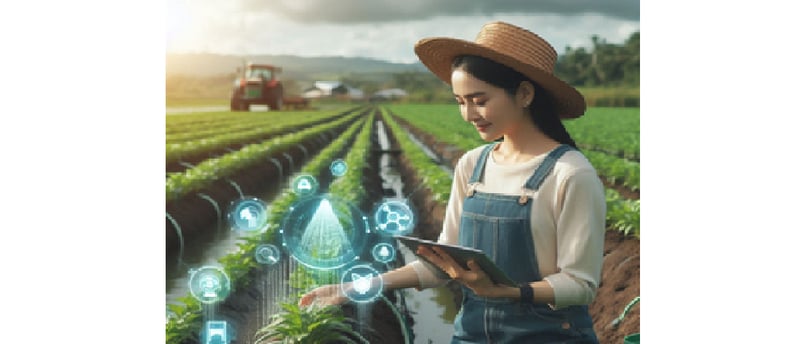Water Wizardry: How Farmers Are Mastering Sustainable Water Use
Meet the water magicians of agriculture! Farmers are rising to the challenge of water scarcity with innovative techniques like precision agriculture, smart irrigation, rainwater harvesting, and drought-resistant crops. #watermanagement #sustainability
AGRICULTURE
Dr. Rizwan Maqbool, Dr. Muhammad Ather Nadeem
5/8/20243 min read


Revolutionizing Agriculture: The Rise of Sustainable Farming Systems
In recent years, sustainable agriculture has emerged as a revolutionary movement in farming. It aims to feed a growing world population while protecting the planet in the long term. At the heart of sustainable agriculture is the philosophy of using resources efficiently and sustainably, such that future generations can also thrive without compromising the health of the ecosystem.
Integrated Farming Systems (IFS) – that combine crops, livestock (including pigs, poultry, and dairy) and, in some cases, fish farming – are spearheading this green revolution. Integrated systems leverage complementarity to take full advantage of land use, improving productivity by up to 100 per cent as compared with separate operations. In particular, inputs from one component feed into the next, turning waste into a resource. For instance, livestock feed on crop residues, while animal manure acts as fertiliser for crops. This synergy leads to cost reductions for farmers and minimises negative environmental impacts.
Conservation agriculture is also changing the world of sustainable farming. Thanks to sophisticated new technologies, such as artificial intelligence (AI) and remote sensing, farmers are beginning to practise precision farming at its best. Precise watering, fertiliser and pesticide application is possible today as never before, due to technologies that have the capacity to sense exactly how much and where to apply these inputs. The permanent soil cover, minimised soil disturbance and crop rotation involved in conservation agriculture make the method very effective in reducing erosion, improving water storage, and enhancing soil biodiversity.
And, despite once being a niche, organic farming is now the fastest growing sector of mainstream agriculture. By shunning synthetic chemicals and genetically modified organisms (GMOs), organic farmers are achieving healthy soils and high biodiversity. Using this back-to-nature model, merged with modern scientific knowledge, they are producing food that, as well as being guaranteed free from toxic residues-rich. The organic industry is also stimulating innovation in natural pest-control and soil-enrichment methods of wider benefit to the whole agricultural sector.
The rise of agroforestry – the intersection of agriculture and forestry – is transforming the idea of farmland. It produces landscapes that are both productive and green: tree crops and shrubbery intermingled with crop and animal farm systems that enhance soil nutrition, reduce wind erosion, and attract pollinators and other beneficial insects, and wildlife. You can have your cake and eat it, too: farms that work with nature, not against it In the tropics, where much of the planet’s existing forest is under threat, agroforestry can form part of the solution, stopping further deforestation and providing sustainable livelihoods for farmers.
But permaculture goes yet further. This next step in sustainable farming can be described as ‘Carbon farmer 2.0’. This approach takes up where fallow farming left off and uses natural processes and design principles to design truly self-sustaining and resilient agricultural systems. Based on the principle that everything is connected, permaculture maps and replicates natural patterns in the wider landscape and at the scale of the individual plant, field and farm. It maximises edge effect (ie, the benefits of increased productivity due to interfaces between land uses), and sees problems as opportunities. For example, in permaculture systems, ‘waste’ products from one element become ‘inputs’ for another, whether that’s compost or livestock manure feeding mushrooms or nut trees, mulch ‘harvested’ from a woodlot generating more biomass from a garden, or pruned fruit trees becoming biomass for a biodigester. These systems create complex, multi-layered gardens and food forests that can produce a huge diversity of crops with minimal inputs and negligible maintenance.
As we seek ways to address global challenges such as climate change, loss of biodiversity and food security, these farming systems are pointing the way to a greener future for agriculture, one that promises to feed the world’s growing population while at the same time reducing harm to our natural resources and the environment
Yet the move to these methods takes time. Sustainable approaches are more labour-intensive and require substantial investments in research, education and infrastructure. Farmers need encouragement and financial incentives to adopt them, which will often be less profitable than the conventional methods at first. Policy makers must provide the regulatory and subsidy framework that encourages sustainable agriculture.
Against that backdrop, despite the formidable hurdles, the sustainability juggernaut continues to roll. The growing consumer demand for sustainably produced food is already changing markets. Technologies are making sustainable practices increasingly efficient and affordable. And the coming years will see a growing share of the world’s farming activity taking place on the sorts of cutting-edge, eco-friendly systems that will feed the planet and nourish its people.
Dr. Rizwan Maqbool
Associate Professor,
Department of Agronomy,
UAF
